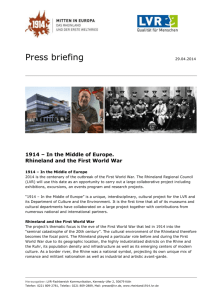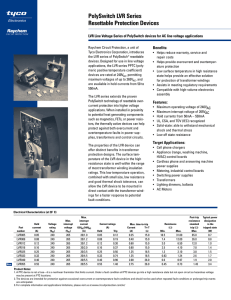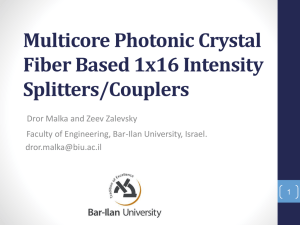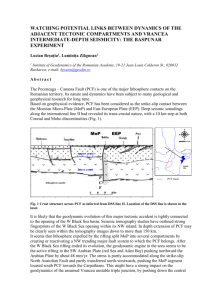Lung Volume Recruitment Policy for Paralytic Disorders
advertisement
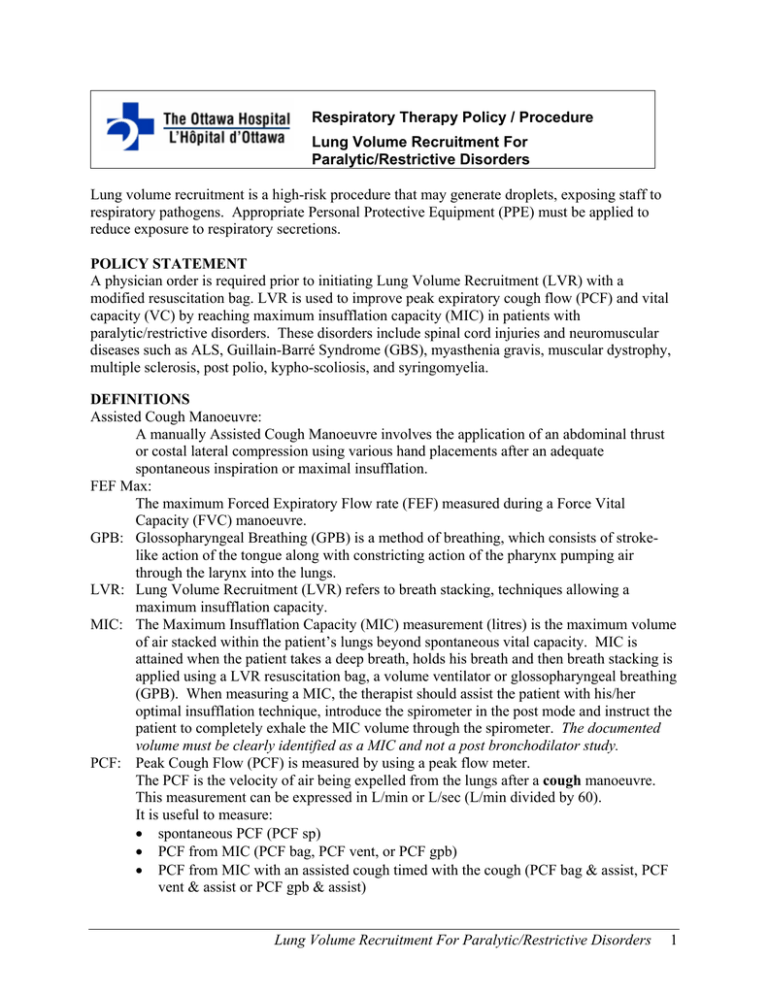
Respiratory Therapy Policy / Procedure Lung Volume Recruitment For Paralytic/Restrictive Disorders Lung volume recruitment is a high-risk procedure that may generate droplets, exposing staff to respiratory pathogens. Appropriate Personal Protective Equipment (PPE) must be applied to reduce exposure to respiratory secretions. POLICY STATEMENT A physician order is required prior to initiating Lung Volume Recruitment (LVR) with a modified resuscitation bag. LVR is used to improve peak expiratory cough flow (PCF) and vital capacity (VC) by reaching maximum insufflation capacity (MIC) in patients with paralytic/restrictive disorders. These disorders include spinal cord injuries and neuromuscular diseases such as ALS, Guillain-Barré Syndrome (GBS), myasthenia gravis, muscular dystrophy, multiple sclerosis, post polio, kypho-scoliosis, and syringomyelia. DEFINITIONS Assisted Cough Manoeuvre: A manually Assisted Cough Manoeuvre involves the application of an abdominal thrust or costal lateral compression using various hand placements after an adequate spontaneous inspiration or maximal insufflation. FEF Max: The maximum Forced Expiratory Flow rate (FEF) measured during a Force Vital Capacity (FVC) manoeuvre. GPB: Glossopharyngeal Breathing (GPB) is a method of breathing, which consists of strokelike action of the tongue along with constricting action of the pharynx pumping air through the larynx into the lungs. LVR: Lung Volume Recruitment (LVR) refers to breath stacking, techniques allowing a maximum insufflation capacity. MIC: The Maximum Insufflation Capacity (MIC) measurement (litres) is the maximum volume of air stacked within the patient’s lungs beyond spontaneous vital capacity. MIC is attained when the patient takes a deep breath, holds his breath and then breath stacking is applied using a LVR resuscitation bag, a volume ventilator or glossopharyngeal breathing (GPB). When measuring a MIC, the therapist should assist the patient with his/her optimal insufflation technique, introduce the spirometer in the post mode and instruct the patient to completely exhale the MIC volume through the spirometer. The documented volume must be clearly identified as a MIC and not a post bronchodilator study. PCF: Peak Cough Flow (PCF) is measured by using a peak flow meter. The PCF is the velocity of air being expelled from the lungs after a cough manoeuvre. This measurement can be expressed in L/min or L/sec (L/min divided by 60). It is useful to measure: • spontaneous PCF (PCF sp) • PCF from MIC (PCF bag, PCF vent, or PCF gpb) • PCF from MIC with an assisted cough timed with the cough (PCF bag & assist, PCF vent & assist or PCF gpb & assist) Lung Volume Recruitment For Paralytic/Restrictive Disorders 1 The PCF correlates well with the actual FEF Max (L/sec) measurement commonly measured with the spirometer. Multiply your FEF value by 60 to obtain a PCF measurement in L/min. CRITERIA The patient must be alert, cooperative with respiratory manoeuvres and able to communicate. CLINICAL INDICATIONS • An established diagnosis as paralytic/restrictive disorder (refer to the Policy Statement section). • A spontaneous PCF less than 280 L/min (2), with or without assisted cough manoeuvre • (at the Ottawa Hospital Rehabilitation Centre (OHRC)- PCF sp must be less than 350 L/min). The FVC less than 50% predicted (1) (OHRC-FVC must be less than 70%). ABSOLUTE CONTRA-INDICATIONS • Presence of haemoptysis, untreated or recent pneumothorax, bullous emphysema, nausea, severe COPD or asthma and recent lobectomy. • Increased intra-cranial pressure (ICP), including ventricular drains. • Impaired consciousness / inability to communicate. • If the patient has an inflated tracheal cuff, DO NOT perform LVR with the manual resuscitation bag. Sufficient airflow around the deflated cuff is required if LVR is introduced via the tracheostomy. • DO NOT perform LVR with a resuscitation bag when your patient has an endotracheal tube in place. RELATIVE CONTRA-INDICATIONS • Therapy immediately following meals • History of COPD and pneumothorax. • Large pleural effusion LVR with a modified resuscitation bag in patients with intrinsic lung diseases (such as COPD, bronchiectasis, CF, pulmonary fibrosis, and asthma to name a few) where secretions may be abundant should be introduced with caution and at times may not be indicated. The efficacy of the treatment in this instance must be monitored by a physician specialized in lung physiology such as a staff respirologist or intensivist. The use of the LVR in other conditions not specified in the policy should be discussed with the care team. Lung Volume Recruitment For Paralytic/Restrictive Disorders 2 PRECAUTIONS • Patients known to have cardiac instability should be monitored for arrhythmias (especially acute SCI), Sp02, dyspnea, vital signs, and symptoms of cardiac instability. • Patients with a combination of intrinsic diseases and paralytic/restrictive disorders must be referred to a staff respirologist or intensivist for consultation. • A pressure manometer, in line with the LVR equipment, is required to minimize maximal insufflation pressure for patients with a combination of primary lung diseases and paralytic/restrictive disorders, unless an order from a staff respirologist or intensivist is written that the manometer is not indicated. • Patients with long-standing thoracic cage restriction who may have severely reduced thoracic compliance will require slow incremental insufflations during the initial LVR introductory period. EQUIPMENT FOR LVR WITH RESUSCITATION BAG • Appropriate PPE • Resuscitation bag, disposable if possible, clearly identified not for CPR • 50 cc corrugated tube • One way valve closest to the bag • One way valve with the inner silicone piece removed, but with the inner screen intact (The modified valve is positioned closest to the patient. • Mouthpiece or mask • Nose clip (optional) LVR with Resuscitation Bag Equipment 1 2 3 4 5 1. 2. 3. 4. Resuscitation Bag 5 50 cc tube One way valve One way valve with silicone piece removed 5. Mouth piece (or mask, or trach adaptor) 6 6. Nose clip 7. Label: “Not for resuscitation” Lung Volume Recruitment For Paralytic/Restrictive Disorders 3 PROCEDURE 1. The LVR technique is best performed in the sitting position; however, this technique can be done in supine. C-spine stabilization must be assessed and the head and neck must always be supported if an assisted cough manoeuvre is performed in coordination with the LVR technique. Assemble the necessary equipment. For ease of reference, visit the web site http://www.irrd.ca/education/slide.asp?slideid=7 2. LVR sessions are usually performed: a) QID and prn if secretions are present, to a maximum of Q10 minutes to avoid hyperventilation b) Ideally before meals and at bedtime c) With assisted cough BID or PRN when indicated 3. Introduce the therapy and the procedure to the patient. 4. Establish with your patient the signal he/she will use to notify you that MIC is reached. 5. With nose clips in place, ask the patient to take a deep breath and hold. 6. Ask the patient to place lips tightly around the mouthpiece to prevent air from escaping. 7. As you gently squeeze the resuscitation bag, coordinate with the patient’s inspiration. Pay attention to possible leaks between the mouthpiece and the mouth. Squeeze the bag 2-5 times until you feel the lungs are full or when the patient sends you a signal that MIC is reached. The patient may feel a stretch in the chest or slight discomfort. 8. Once the patient’s lungs are full, take the mouthpiece out of the mouth, ask the patient to hold the maximum insufflation for 3 to 5 seconds, and then allow the patient to exhale gently. 9. Repeat steps 5-8, 3 to 5 times. 10. If secretions are present, ask the patient to produce a strong cough or include an assisted cough manoeuvre when indicated (i.e., instead of gently letting the air out). Helpful Hints • If air escapes around the patient’s mouth, assess the method of delivery and selection of interface. • As the patient becomes proficiency with LVR, nose clips may not be necessary. DOCUMENTATION Clinical documentation includes: • Physician order FVC, FEV1, FEF & MIC, FEF with LVR (by spirometry) LVR Q4H while awake and PRN • General respiratory assessment taking into consideration Clinical indications Contra-indications Precautions • Initial LVR treatment Pre-therapy Chest assessment, FVC, FEV1, FEF, (by spirometry for non intubated patients only) Sp02, pulse rate & MIP/MEP if possible Optional: PCF sp (non intubated patients only) Lung Volume Recruitment For Paralytic/Restrictive Disorders 4 • Introduce LVR Measure MIC, FEF with LVR Optional: PCF with LVR & FCF with LVR & assisted cough manoeuvre where applicable Post-therapy Document the ease of air flow, visual assessment of sputum consistency/volume/color and patients adaptability to treatment Subsequent therapy Ease of treatment application Sp02 and pulse rate if necessary Weekly PCF bag (& assist if indicated) to assess treatment efficacy REFERENCES 1. Bach JR: Pulmonary Rehabilitation – The Obstructive and Paralytic Conditions. Pg 285 – 352 & 325, 1996 2. Bach JR: Guide to the Evaluation and Management of Neuromuscular Disease, Pg 107, 1999 3. McKim D, LeBlanc C, Walker K, Liteplo J: http://www.irrd.ca/education/presentation.asp?refname=e2r1 , 2002 4. McKim D, Walker K, LeBlanc C: Amyotrophic Lateral Sclerosis: Achievement of maximum Insufflation Capacity and Peak Cough Flows, Abstract – 12th International Symposium on ALS/NMD Oakland November 2001 5. LeBlanc C, Walker K, McKim D, Marcogliese G, Trevoy J, Liteplo J: Education in Respiratory Care Protocols for Spinal Cord Injury and Diseases March 2001 6. McKim D, LeBlanc C, Walker K: Determinants of Peak Cough Flow in Patients with Amyotrophic Lateral Sclerosis, Chest 2001 7. McKim D, LeBlanc C, Walker K, Thivierge C: Achievement of Maximum Insufflation Capacity and Peak Cough Flows in Spinal Cord Injury, 7th International Conference on Home Mechanical Ventilation 1999 Policy Developed by: Policy developed by: Carole LeBlanc RRT, Asthma / COPD Educator Professional Practice Leader, Respiratory Therapy The Ottawa Hospital Rehabilitation Centre Douglas A McKim MD, FRCPC, FCCP, D,ABSM Medical Director, Respiratory Rehabilitation Services Associate Professor, Department of Medicine University of Ottawa Respiratory Therapy Leaders The Ottawa Hospital Revised - April 2007 Lung Volume Recruitment For Paralytic/Restrictive Disorders 5
